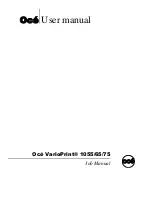
6-18
●
Transmission Sequences
6.4.2 Printings Transmission
6.4.2-1 Text
(1) When printings are to be changed
DLE Item number
Printings (10 digits max.)
(2) When all 10 digits of printings are to be invalidated
DLE Item number
(3) When multiple printings are to be designated
DLE Item number
Printings
DLE Item number
Printings change
Printings erasure
●
Multiple print items can be consecutively transmitted within one session.
●
Print items are to be designated by specifying the item numbers.
The item numbers need not be sorted.
6.4.2-2 Text
6.4.2-2 Item number
Item number
1
2
...
10
...
24
25
...
100
Code
(31)H (32)H
...
(3A)H
...
(48)H (49)H
...
(94)H
The parenthesized value positioned to the left of H is a hexadecimal number.
: Enabled when the print item count addition option is employed
.
●
The order of print items is indicated below
(3-column example) Circled number: Item number.
1st column 2nd column
[ ] [ ]
[ ] [ ]
[ ] [ ]
1
2
3
4
5
6
6.4.2-3 Printings
●
An array of "character codes" which consist of 10 or fewer digits.
●
When the number of digits is less than 10, the IJ printer adds NUL to the end of
the array for interpretation purposes.
●
The coding system varies with the mode which is designated by the "Number of
communication bytes" setting entered form the communication environment
setup screen.
Number of
communication
bytes
Alphanumerical
characters and
symbols
Dedicated
characters
User pattern
Punctuation
mark
Katakana
(00 to 47)
(48 to
127)
1-byte mode
ASCII
ASCII
ASCII
2-byte
code
2-byte code
2-byte
code
2-byte mode
ASCII
2-byte
code
2-byte
code
2-byte
code
2-byte code
2-byte
code
Summary of Contents for PH
Page 288: ...2 K5253 1 ...
















































